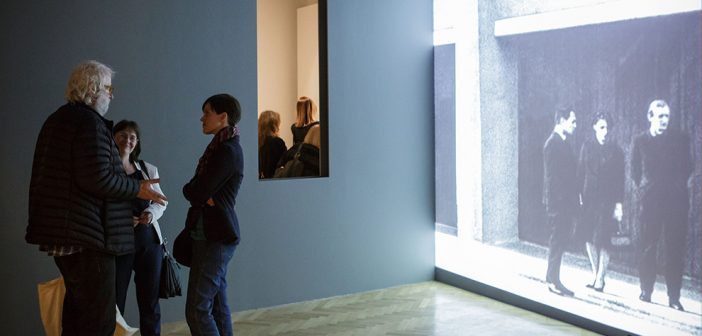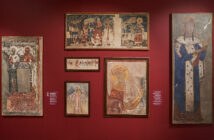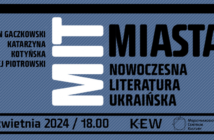An exhibition of those who went against the flow.
The vanguard is a state of mind – says the German critic and art historian, Ulrich Bischoff. As does Jacek Sroka, one of several contemporary Polish artists whose works can be seen in the exhibition ‘The Power of the Avant-Gard’ at Szołayski House, a branch of the National Museum in Kraków. The exhibition confirms their opinion: there is a surprising arrangement of pink plates fixed asymmetrically to the wall of the burgher’s tenement, as well as 84 works by famous artists, artists considered avant-garde in their day, such as Fernand Léger, Max Ernst, Hans Arp, Piet Mondrian, Alexandr Archipenko, Kazimierz Malewicz and Edvard Munch. These works created early in the twentieth century are shown alongside contemporary works by artists such as David Claerbout, William Kentridge and Sean Scully, as if creating a dialogue with the so-called avant-garde ‘classics’. The exhibition is the result of the cooperation between Kraków`s National Museum and the BOZAR Museum of Fine Arts in Brussels, which recently organized an exhibition entitled ‘The Power of the Avant-Garde: Now and Then’. The Polish curators, Magdalena Czubińska and Andrzej Szczerski, deputy director of NMK, ensured the works of Polish artists, including Leon Chwistek, Katarzyna Kobro, Władysław Strzemiński, Monika Sosnowska and Jerzy Panek, were included in the exhibition. – The avant-garde artist is one who undertakes experimentation. And this exhibition is a selection, not an overview, which focuses on the fact that the avant-garde artists wanted to change the world. The avant-garde movements of the first quarter of the twentieth century carried an enormous emotional, intellectual and, in some cases, socio-political load. This was accompanied by much optimism and a belief in the possibility of repairing the world – and the transformation of man. The two world wars and the experience of European totalitarianism changed these attitudes. Thus, the dialogue to which the visitors are invited seems all the more interesting – says Magdalena Czubińska, curator of ‘The Power of the Avant-Garde’.
The exhibition is included within the celebratory programme centred on the Year of the Avant-garde in Poland, under the honorary patronage of the President of Poland, Andrzej Duda, and under the auspices of the Polish Committee for UNESCO.
The Power of the Avant-Grade • March 10 – May 28, 2017
National Museum in Kraków • Feliks Jasieński Szolayski House • pl. Szczepański 9

Potęga awangardy
Wystawa o tych, którzy szli pod prąd.
Awangarda to stan umysłu – mówi niemiecki krytyk i historyk sztuki Ulrich Bischoff. Zgadza się z nim Jacek Sroka, jeden z kilku współczesnych polskich artystów, których prace można oglądać na wystawie „Potęga awangardy” w Kamienicy Szołayskich, oddziale Muzeum Narodowego w Krakowie. Ekspozycja potwierdza ich słowa: w zaskakującej aranżacji, na różowawych płytach przytwierdzonych asymetrycznie do ścian mieszczańskiej kamienicy możemy oglądać 84 dzieła wielkich i klasycznych już dla historii sztuki artystów, takich jak: Fernand Léger, Max Ernst, Hans Arp, Piet Mondrian, Aleksandr Archipenko, Kazimierz Malewicz czy Edvard Munch. Pracom tworzonym w pierwszych dekadach XX wieku towarzyszą współczesne, prowadzące dialog z „klasykami” awangardy, autorstwa Davida Claerbouta, Williama Kentridge’a czy Seana Scully’ego. Scenariusz jest rezultatem współpracy krakowskiego Muzeum z Centrum Sztuk Pięknych BOZAR w Brukseli, gdzie na jeszcze kilka miesięcy temu można było oglądać wystawę The Power of the Avant-Garde. Now and Then. Polscy kuratorzy Magdalena Czubińska i wicedyrektor MNK Andrzej Szczerski zadbali o to, by nie zabrakło rodzimych twórców: Leona Chwistka, Katarzyny Kobro, Władysława Strzemińskiego, Moniki Sosnowskiej czy Jerzego Panka. – W sztuce artysta awangardowy to taki, który podejmuje się eksperymentowania. Ta wystawa to wybór, a nie panorama. To wystawa o tym, że awangarda szczerze chciała zmieniać świat. Awangardowe ruchy pierwszej ćwierci XX wieku niosły ze sobą olbrzymi ładunek emocjonalny, intelektualny, a w niektórych wypadkach także społeczno-polityczny. Towarzyszył im optymizm i wiara w możliwość naprawy świata – i przemianę człowieka. Dwie wojny światowe i doświadczenia totalitaryzmów europejskich zmieniły to nastawienie. Tym bardziej interesujący wydaje się dialog, do którego zapraszamy także widza – mówi kuratorka „Potęgi awangardy” Magdalena Czubińska.
Ekspozycja wpisuje się w Rok Awangardy w Polsce, objęty honorowym patronatem Prezydenta RP Andrzeja Dudy oraz pod auspicjami Polskiego Komitetu ds. UNESCO
Potęga awangardy • 10 marca – 28 maja 2017 • Muzeum Narodowe w Krakowie
Kamienica Szołayskich im. Feliksa Jasieńskiego • pl. Szczepański 9









